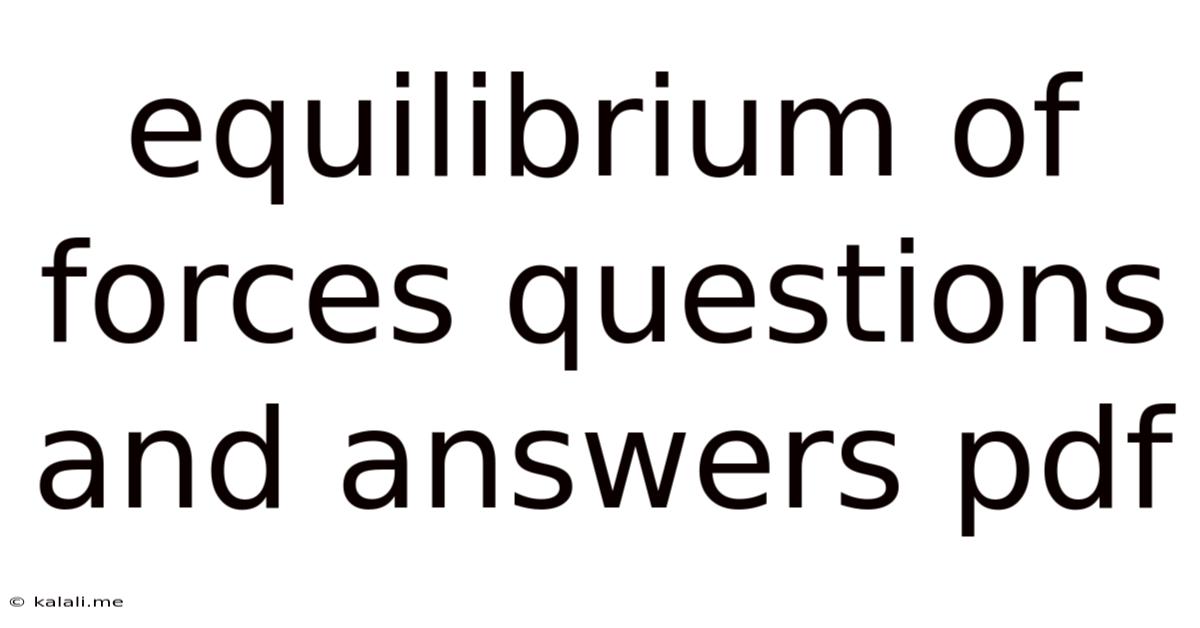Equilibrium Of Forces Questions And Answers Pdf
Kalali
Jun 13, 2025 · 3 min read

Table of Contents
Equilibrium of Forces: Questions and Answers
This article provides a comprehensive overview of equilibrium of forces, addressing common questions and misconceptions. Understanding equilibrium is crucial in various fields like physics, engineering, and structural analysis. We'll explore the concepts through examples and explanations, making this a valuable resource for students and anyone interested in learning more. This article aims to help you master the concepts and solve problems related to static equilibrium.
What is Equilibrium of Forces?
Equilibrium, in the context of forces, means a state where the net force acting on an object is zero. This doesn't necessarily mean there are no forces acting on the object; rather, it means that all the forces acting on it cancel each other out. A body in equilibrium will either remain at rest or continue moving at a constant velocity (Newton's First Law). This condition is essential for the stability of structures and objects.
Types of Equilibrium
There are three main types of equilibrium:
- Stable Equilibrium: If a body is slightly displaced from its equilibrium position, it tends to return to that position. Think of a ball resting at the bottom of a bowl.
- Unstable Equilibrium: If a body is slightly displaced, it moves further away from its equilibrium position. Imagine balancing a pencil on its tip.
- Neutral Equilibrium: If a body is displaced, it remains in its new position. A ball rolling on a flat surface is an example.
Key Concepts and Equations
Understanding the following concepts is crucial for solving equilibrium problems:
- Free Body Diagram (FBD): A visual representation of an object showing all the forces acting upon it. Drawing accurate FBDs is essential for successfully analyzing equilibrium problems.
- Newton's Laws of Motion: Especially the first and second laws are directly applicable. Newton's First Law directly defines equilibrium, and the second law helps calculate forces (F=ma). In static equilibrium, acceleration (a) is zero.
- Resolution of Forces: Breaking down forces into their horizontal and vertical components. This is often necessary to simplify complex situations and apply equilibrium conditions.
- Principle of Moments (Torque): For rotational equilibrium, the sum of clockwise moments must equal the sum of anticlockwise moments about any point. This principle is particularly important when dealing with problems involving levers, beams, and other rigid bodies.
Common Equilibrium Problems and Solutions
Many problems involving equilibrium can be solved using the following steps:
- Draw a Free Body Diagram: Clearly represent all forces acting on the object.
- Resolve Forces: Break down forces into their x and y components.
- Apply Equilibrium Conditions: The sum of forces in the x-direction equals zero (ΣFx = 0), and the sum of forces in the y-direction equals zero (ΣFy = 0). For rotational equilibrium, the sum of moments about any point equals zero (ΣM = 0).
- Solve the Equations: Use algebra to solve for the unknown forces or angles.
Example Problem:
A 10 kg mass hangs from a rope that is tied to two other ropes, creating a 30-degree angle on each side. Find the tension in each of the two supporting ropes. (Ignoring the weight of the ropes themselves).
This problem requires resolving the weight of the mass into its components and then applying the equilibrium conditions to solve for the tension in each supporting rope. The solution involves using trigonometry and the equilibrium equations.
Conclusion:
Mastering equilibrium of forces requires practice and a clear understanding of the underlying concepts. By consistently applying the steps outlined above—drawing FBDs, resolving forces, applying equilibrium conditions, and solving the resulting equations—you can confidently tackle a wide range of equilibrium problems. Remember that consistent practice with different problem types is key to improving your skills and understanding in this area of physics. Further exploration of advanced topics like trusses and frames will build upon this fundamental knowledge.
Latest Posts
Latest Posts
-
How Many Cups Are In 3 Quarts
Jul 01, 2025
-
Four Letter Word With Second Letter A
Jul 01, 2025
-
How Many 1 8 Cups Are In 2 3 Cup
Jul 01, 2025
-
How Many Slices Of Turkey In 2 Oz
Jul 01, 2025
-
Omnipoint Miami E License Llc Miami Fl
Jul 01, 2025
Related Post
Thank you for visiting our website which covers about Equilibrium Of Forces Questions And Answers Pdf . We hope the information provided has been useful to you. Feel free to contact us if you have any questions or need further assistance. See you next time and don't miss to bookmark.